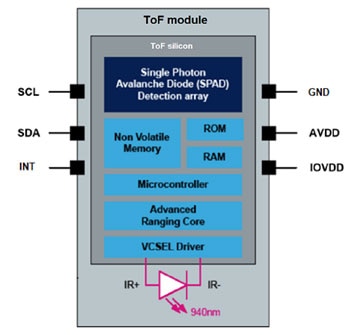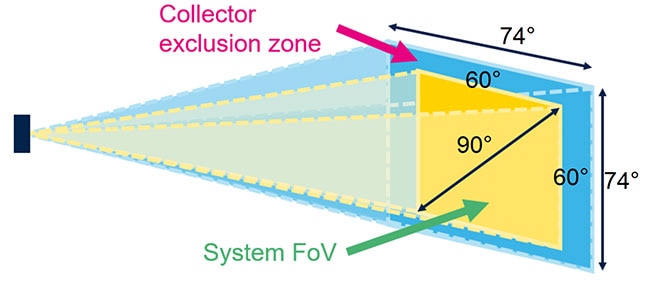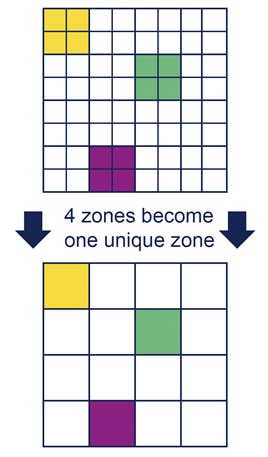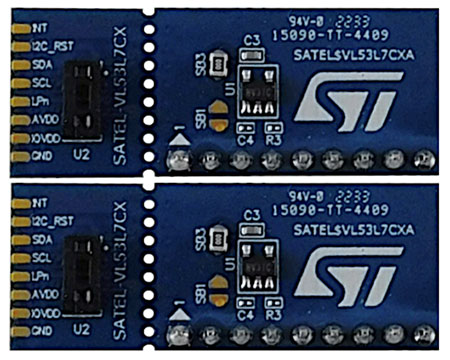Simply and Quickly Add Time-of-Flight Proximity Detection for Greater Accuracy
Proximity detection is becoming a key requirement for both the Internet of Things (IoT) and conventional automation, as well as for DIY projects. The simplest applications include motion detectors that switch on lights when people approach and level detection for material and liquids in trucks, tanks, and waste bins. More complex systems work for robotic vacuum cleaners, assembly machines, and virtual reality (VR).
There are several techniques for allowing machines to determine what’s around them. For example, Bluetooth Low Energy (LE) transceivers can estimate the distance to similar transceivers from a measurement of the received signal strength. Other devices use the disturbance of a magnetic field to detect when something is nearby. These techniques are inexpensive and effective but only provide a rough estimate of the distance between two objects. This is useful, for example, when activating a light or triggering a motion alarm, but less practical when guiding an unmanned vehicle around a crowded warehouse or indicating the precise location of an expensive asset.
Greater accuracy comes from taking advantage of one of nature’s immutable constants, the speed of light (c). By shining a laser beam (or other forms of electromagnetic radiation, for example, microwaves) at an adjacent object and accurately timing the flight duration between emission and receiving a reflected signal, a simple calculation reveals the distance to the object:
Time of flight (ToF) in seconds (s)/2 x c in meters per second (m/s) = distance to object in meters (m)
While the calculation is trivial, building a sensor to perform the measurement is anything but. Fortunately, there is a commercial module available to do the job and a fair bit more besides.
A wide field of view ToF sensor
One example of this new breed of time-of-flight (ToF) sensors is STMicroelectronics’ VL53L7CXV0GC/1. The module incorporates an efficient vertical cavity surface emitting laser (VCSEL) operating in the infrared (IR) spectrum (making it safe for human eyes) that fires its beam at objects up to 3.5 m away. The module is equipped with a single-photon avalanche diode (SPAD) array with IR filters that detect the reflected signal. An MCU and associated memory, plus the company’s proprietary software, performs the ToF calculation. All the electronics are contained in a compact form factor of 6.4 by 3.0 by 1.6 millimeters (mm) (Figure 1).
 Figure 1: The VL53L7CX ToF module features an IR laser, multizone SPAD array, MCU, and memory in a compact package. (Image source: STMicroelectronics)
Figure 1: The VL53L7CX ToF module features an IR laser, multizone SPAD array, MCU, and memory in a compact package. (Image source: STMicroelectronics)
The VL53L7CX module brings some other interesting features you will find useful. For example, it incorporates an efficient “metasurface” lens placed on the laser emitter that enables the projection of a 60° by 60° square (90° diagonal) field of view (FoV) (Figure 2). The advantage of this is that the sensor “sees” a wider area and more objects from any given position.
 Figure 2: The VL53L7CX ToF sensor offers a wide field of view from a given orientation, enabling it to locate multiple objects. (Image source: STMicroelectronics)
Figure 2: The VL53L7CX ToF sensor offers a wide field of view from a given orientation, enabling it to locate multiple objects. (Image source: STMicroelectronics)
The collector exclusion zone shown in Figure 2 considers the module assembly tolerances and is used to define the cover window dimensions. The cover window opening must be equal to—or wider—than the exclusion zone. (Note: Image not to scale.)
The other key trick the VL53L7CX has up its sleeve for you is that the SPAD array consists of 64 zones in an 8 by 8 matrix. Each zone works as an independent sensor. STMicroelectronics’ patented algorithm allows the VL53L7CX to detect multiple objects in each zone within the FoV, together with depth perception. The sensor calculates an absolute distance to the object regardless of the target color and reflectance.
You can choose to operate the SPAD array matrix in a high-resolution mode (8 by 8) at a low refresh frequency of 15 Hertz (Hz) or in a 4 by 4 mode at a higher refresh rate of 60 Hz (Figure 3). The resolution and refresh rate you choose depends upon the speed, power consumption, and other requirements of your application, of course.
 Figure 3: The VL53L7CX ToF sensor allows you to change the 8 by 8 sensor matrix to a 4 by 4. While resolution is decreased, the refresh rate is increased by 4x. (Image source: STMicroelectronics)
Figure 3: The VL53L7CX ToF sensor allows you to change the 8 by 8 sensor matrix to a 4 by 4. While resolution is decreased, the refresh rate is increased by 4x. (Image source: STMicroelectronics)
Development and production tools for the ToF sensor
STMicroelectronics has introduced some useful tools to help you get started on a ToF sensor-based design. The X-NUCLEO-53L7A1 expansion board, for example, is designed for use with any STM32 Nucleo board equipped with Arduino R3 connectors. STM32 Nucleo development boards allow engineers to create prototypes with any STM32 microcontroller. The expansion board is essentially a complete evaluation kit for the VL53L7CX ToF sensor.
Several STMicroelectronics expansion boards can be stacked using Arduino connectors. You could, for example, use the X-NUCLEO-53L7A1 expansion board together with a Bluetooth LE or Wi-Fi board to send proximity data to the cloud.
In addition to the evaluation board, STMicroelectronics offers the SATEL-VL53L7CX, a package comprising two breakout boards. Each breakout board features a VL53L7CX module, a 3.3 volt voltage regulator, plus some peripheral components (Figure 4).
 Figure 4: The SATEL-VL53L7CX package comprises two ToF sensor breakout boards, each with a VL53L7CX sensor on one side (left) and a 3.3 volt voltage regulator on the other. (Image source: STMicroelectronics)
Figure 4: The SATEL-VL53L7CX package comprises two ToF sensor breakout boards, each with a VL53L7CX sensor on one side (left) and a 3.3 volt voltage regulator on the other. (Image source: STMicroelectronics)
In their complete form, you can attach the breakout boards to the expansion board using the Arduino connectors to create a system comprising three ToF sensors (two breakout boards plus the sensor on the evaluation kit). The breakout boards are perforated, so the section with the ToF sensor forms a mini-printed circuit board (pc board) that is easy to wire into an application assembly based on a 3.3 volt power supply. The breakout boards accelerate evaluation and development, shortening time-to-market.
Conclusion
Proximity detection is an increasingly useful feature to add to your IoT devices and other systems. The precision that ToF sensors bring opens up a whole new set of more complex applications, along with more complex design issues. The VL53L7CX IR ToF sensor and its evaluation tools remove much of that complexity while giving you a wide FoV, scalable resolution, and multi-object detection capability.

Have questions or comments? Continue the conversation on TechForum, Digi-Key's online community and technical resource.
Visit TechForum










 中国
中国